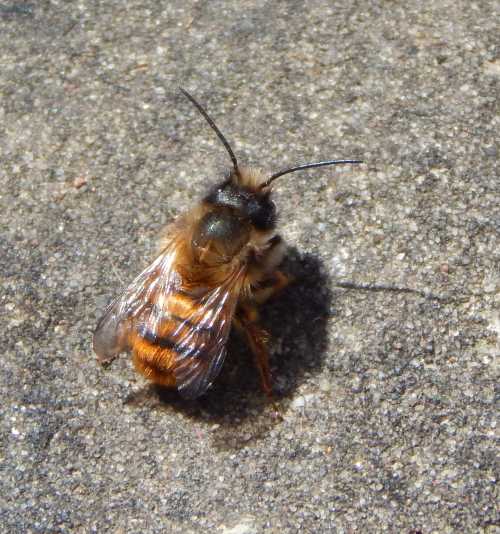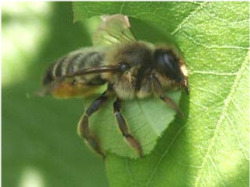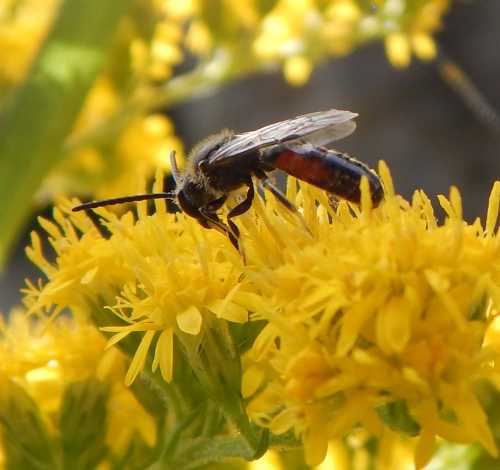Wild Bees
Are Important Pollinators
Updated: 24th February 2021
Wild bees are vital pollinators within our eco-system. Whilst honey
bees are well recognised for their role in pollination of food crops, the contribution of their wild
cousins is often unrecognised, although this is changing, if rather
slowly!
It's worth remembering that there are relatively few wild honey bee colonies. Humans have long kept bees through history, but the resurgence in beekeeping is a fairly recent phenomenon, and so you have to ask yourself this question:
"given that honey bees are often limited in location by the presence of beekeepers and where they keep their hives, which species have been pollinating the vast majority of gardens, allotments, countryside, and public planting schemes all these years?"
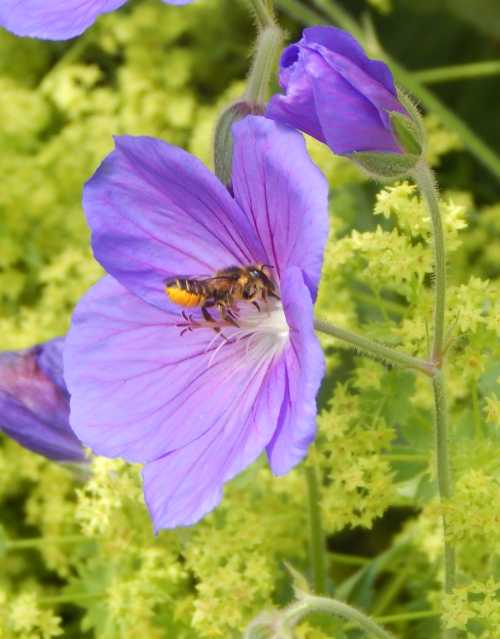 Leafcutter bee visiting geranium flower.
Leafcutter bee visiting geranium flower.The answer of course has to be wild bees, along with a zillion other unsung pollinating heroes from flies, wasps and butterflies to moths and beetles.
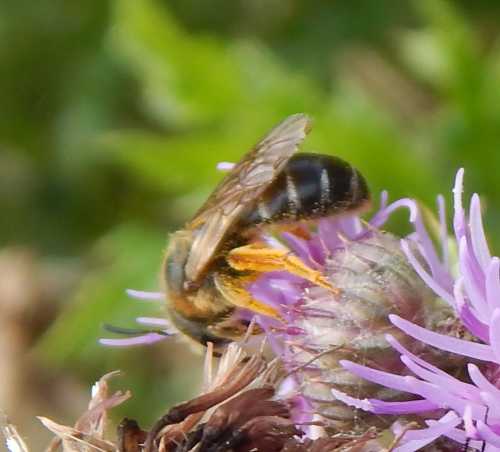 Orange-legged furrow bee.
Orange-legged furrow bee.
This does not mean that honey bees are irrelevant. Honey bees play an extremely important role. Honey bees are absolutely vital for some crops, such as almonds. In addition, a honey bee colony is a fascinating super organism. See below for a link to further information about the importance of honey bees.
But indeed what we have to accept is that, insect pollination generally is vital for many crops, and yet, with the a few exceptions, we hardly
know which species is best suited to pollinate which plant or food crop!
So, here are a few snippets of information about wonderful wild bees, especially with regard pollination.
The Importance Of Wild Bees For Pollination
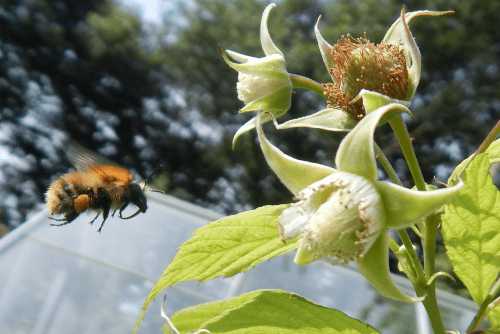 The common carder bumble bee is one of a number of species that pollinates raspberry flowers.
The common carder bumble bee is one of a number of species that pollinates raspberry flowers.- Some plants require buzz pollination in order that pollen be released from the anthers and the plant is pollinated. Not all bees are able to ‘buzz pollinate’ which involves releasing
pollen by shaking it from the anthers in flowers. manage this
by placing their thorax close to the anthers and vibrating their flight
muscles, thus shaking the pollen from the anthers.
They are therefore excellent pollinators of tomatoes and other fruits, and pollination by bumble bees results in more abundant crops (the Dutch have been using bumble bees commercially for pollination since the 1980s).
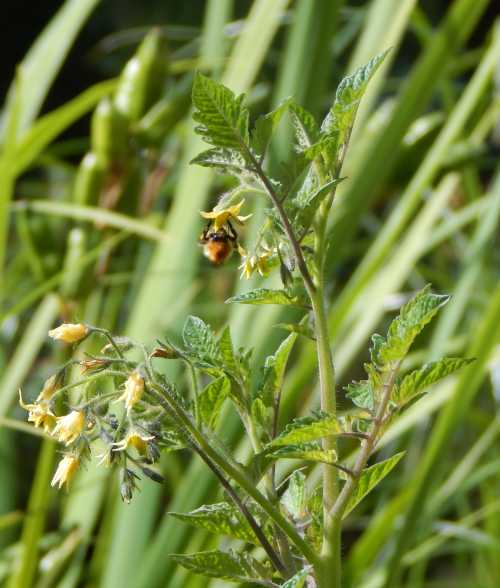 Bumble bee visiting tomato flower.
Bumble bee visiting tomato flower.- The southeastern blueberry bee (Habropoda laboriosa)
of the southeastern United States is another example of a bee that is
able to buzz pollinate. This species forages primarily on blueberries.
The southeastern blueberry bee attaches herself to the blueberry flower and vibrates her flight muscles very rapidly, which releases pollen from the flower which is then collected by the bee. Of course, some of the pollen shaken from the flower clings to the hairy body of the bee, and is transferred from one flower to another, causing pollination to occur.
- Different bee species have differing body shapes, weights and tongue
lengths. Basically, some are better adapted for pollinating certain
plants than other species. For this reason, all bee species (and
other pollinators!) are important.
- Some wild bees are super-efficient pollinators! A study by Bosch and Kemp, 2001 showed that only 250 female Osmia lignaria (blue orchard bees - or orchard mason bee) are required to pollinate an acre of apples, yet this would usually have needed the service of one to two honey bee hives, with 15,000 to 20,000 workers in each! Indeed, the general role and value of mason bees in pollination is increasingly being recognised.
- Some bees pollinate faster
than others! Under similar conditions, bumble bees reportedly pollinate
more flowers per bee than honey bees (from: Bumblebees Behaviour and
Ecology; Prof. Dave Goulson; citing Poulson 1973; Free 1993).
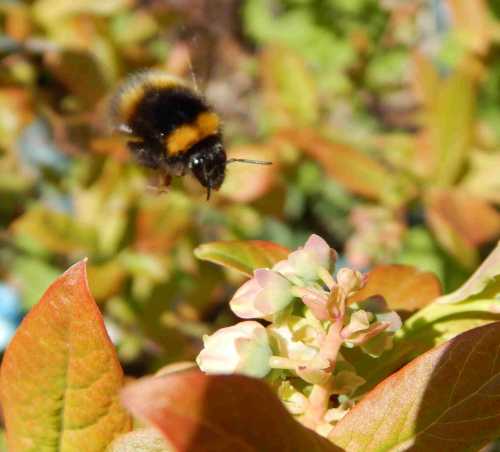 Above: Bumble bee heading for blueberry flowers
Above: Bumble bee heading for blueberry flowers
However, we need to be realistic....
Some studies (such as Corbet
et al 1993) state that some bumble bee species especially, are quite
tough little creatures, and are able to pollinate during adverse weather
conditions, such as cold weather. Indeed, you can learn about how the
bumble bee queen gets warmed up as she emerges following hibernation, and
prepares to face a cool morning on this page (opens new window):
Bumble bee queen. However, the fact remains that few wild bees are around to pollinate crops early in the winter January/February months.
Some bumble bee species do not even emerge until later in the year, and it takes time for a colony to become established with workers. I have, however, seen wild honey bees active in very cold conditions when no other pollinators were to be seen.
Indeed, Wilson & Messinger Carril, authors of - The Bees In Your Backyard comment:
"One aspect of honey bee biology that makes them particularly valuable for agriculture is that they are active primarily on the basis of temperature rather than seasonality the way other bees are. Honey bees are most active between 60 °F and 105 °F, though they can forage at temperatures as low as 55 °F. This characteristic makes them valuable pollinators of crops that bloom before many native bees are active. For example, almond trees in California will flower in February, earlier than most native bees typically emerge, but honey bees will effectively pollinate the almond trees as long as the temperature is warm enough. The ability of honey bees to forage at such a large range of temperatures means that they are active somewhere in North America during every month of the year".
Conclusion
Quite simply, all pollinators have their role to play, and that includes all bee species as well as a myriad other pollinators.
Read about the Chocolate Mining Bee
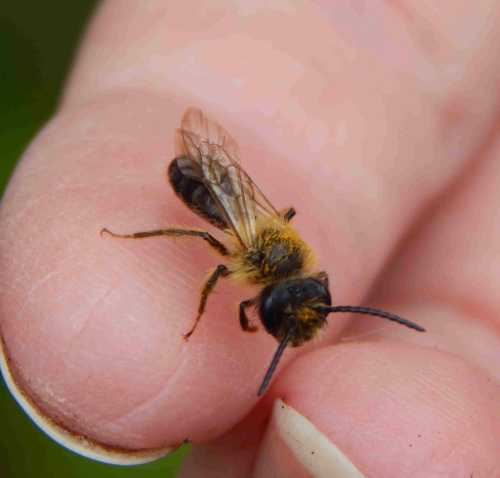
If you found this page helpful or interesting, I'd really be grateful if you would share it with others - if not this page, perhaps another, such as Gardening For Bees.
Thank you so much :) .
